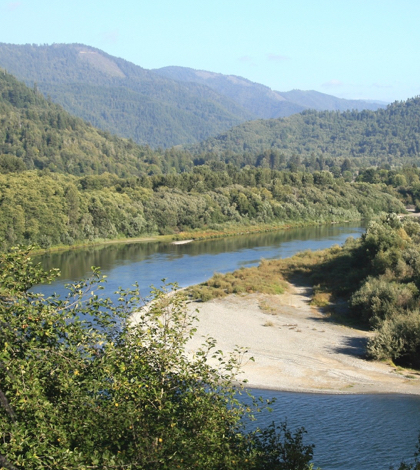Removal in 2020 Focuses on Federal Energy Regulatory Commission Approval
Gathered at the Yurok Reservation in Klamath in Del Norte County, California on Wednesday, were a diverse group to witness the announcement of a long-awaited agreement. Republican Congressman Greg Walden (Oregon, District 2); Democratic Congressman Jared Huffman (California, District 2); California Gov. Jerry Brown; Oregon Gov. Kate Brown (no relation); Interior Secretary Sally Jewel; National Oceanic and Atmospheric Agency Administrator Kathryn Sullivan; and, Stefan Bird, chief executive of Pacific Power (a division of PacificCorp and a Berkshire Hathaway subsidiary) along with local farmers, ranchers and leaders of multiple Indian tribes were on hand to announce a landmark agreement to tear down four hydroelectric dams on the Klamath River.
The announcement, made at the Requa Resort Boat ramp, focused on water supply reliability, environmental restoration, the four aging hydroelectric dams and the negotiations. The watershed and its fisheries have been the subject of negotiations since the 1860s and the river has provided irrigation to its surrounding agricultural lands since the late 19th century.
An agreement struck in 2010 focused on dismantling the dams. The agreement would have also restored tribal lands and given more water rights to farmers and ranchers. Four Klamath-area Native American tribes have relied on the river for its once-abundant salmon for the tribes’ subsistence and cultural lifestyle. They have scorned the dams for causing water quality to suffer, thwarting salmon migration, shifting water flows and furthering toxic algae blooms.
“That’s our livelihood,” said Thomas O’Rourke Sr., chairman of the Yurok Tribe in Northern California. “If the river’s sick, our fish are sick, the animals that live around it become sick, and the people become sick.” O’Rourke claims that the Klamath River can begin to heal if the dams come down.
Farmers and ranchers, at the top of the basin, have relied on the Klamath for water to irrigate their fields as well as the hydroelectric power to run their irrigation pumps. Under the agreement announced yesterday farmers have agreed to use less water, though it means some acreage will be fallowed, in exchange for a minimum water-supply guarantee excepting drought periods. Farmers have agreed to using other types of energy once the dams are removed.
But in spite of the hard-driven negotiations between all invested parties, the 2010 agreement has not been without its late-breaking problems. By late December, after five years awaiting congressional approval of the Klamath agreement, the plan expired when Congress failed to approve the removal of the four dams.
Undeterred, a non-profit corporation was formed that proposed to take ownership of the dams. They have agreed to assume any liability for damages incurred from the removal of the dams, according to Bob Gravely, spokesperson for PacifiCorp of Portland, OR. Though the plan must obtain the approval from the Federal Energy Regulatory Commission that authorization would negate the need for congressional approval to remove the dams.
“What we believe we’ve found here is a way to go forward that doesn’t require approval from Congress,” said Gravely.
Commissioned in the 1940s and ‘50s for hydroelectric power, not for water storage or to prevent flooding, the dams are now regarded as antiquated. Keeping them could cost as much as removing them; estimated costs for modernization are projected to total about $400 million. Relicensing the dams would entail construction of fish ladders and other costly capital enhancements.
Costs to remove the four dams are projected to run as high as $450 million. PacifiCorp has agreed to pay the first $200 million to remove the J.C. Boyles, Iron Gate, and Copco 1 and 2 dams. California’s Gov. Brown will seek legislative approval for $250 million from the 2014 water bond to complete the project. No federal funds will be sought to dismantle the dams.
Although the new agreement announced Wednesday is not identical to the comprehensive plan ironed out by farmers, tribal leadership and conservation groups and presented to state and federal legislators and water officials in 2010. However, removal of the dams will allow endangered salmon and steelhead to return to parts of the river which they have not accessed in almost a century. The new agreements look to safeguard upriver farmers and ranchers from increasing water costs or reduced water supply because of measures set out to protect those same fish.
“The essence of the deal is a private dam owner who wants to get rid of these zombie dams that don’t provide a lot of hydropower and have huge environmental liabilities, and can be a part of a transformative river restoration,” said California’s Congressman Huffman. “None of this requires any approval or authority or appropriation from Congress.”
Although some details need to be worked out in order to satisfy all of the involved Native American Tribes most of those involved hailed the new plan.
 California Water News Daily Your Source For Water News in California
California Water News Daily Your Source For Water News in California


